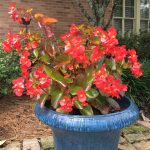
Start by choosing the right spot for the plants that you will grow. If the plants are shade-loving, putting them in direct sunlight will bring many challenges for you and ultimately, the plants may die. On the other hand, if the plants require direct sunlight to grow and flower, be sure the spot you choose is best for the plant so it will thrive and produce beautiful blossoms.
First, choose hardy plants that are heat-resistant or those with an extensive root system. Annuals vary from heat-lovers to heat-haters, so it’s best to match the plant to the place. While it may be 
Before planting, fertilize the soil well using organic compost and other fertilizers. When planting, 
Continue to fertilize the plants, following the instructions for the particular fertilizer, but do not over-fertilize. The plant will get many of its nutrients from the soil. Fertilizing correctly will not only give plants a boost but will help them in times of stress.

Use mulch. Mulch protects the soil from the sun and helps it to retain moisture. There are many types of mulch from which to choose, or you can make your own with newspaper or cardboard.
Water frequently, particularly in areas where the temperature is above 90 degrees. Make sure the root ball gets water. The soil should be wet 6” down. Instead of guessing, use a trowel and check the depth of wet soil. Keep your garden weeded as weeds will compete with plants for water and nutrients.

While it may take some experimenting to find the correct plant for the area and the appropriate watering and fertilizing for the plants, the work is gratifying when it produces the look you want.
Come stay with us and visit our garden!


